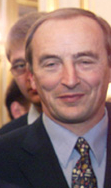Jean-Pierre Haigneré (born 19 May 1948) is a French Air Force officer and a former CNES spationaut.
Jean-Pierre Haigneré | |
|---|---|
 | |
| Born | 19 May 1948 Paris, France |
| Status | Retired |
| Nationality | French |
| Occupation | Test Pilot |
| Space career | |
| CNES Spationaut | |
| Rank | Brigadier General, French Air Force |
Time in space | 209d 12h 25min |
| Selection | 1985 CNES Group 2, 1998 ESA Group |
| Missions | Soyuz TM-17, Mir Altair, Soyuz TM-16, Soyuz TM-29, Mir Perseus (EO-27) |
Mission insignia | |
Jean-Pierre Haigneré was born in Paris, France, and joined the French Air Force, where he trained as a test pilot.[1]
He flew on two missions to the Mir space station in 1993 and 1999. The Mir Perseus (Mir EO-27) long-duration mission (186 days) in 1999 also included an EVA.[2] In addition to his duties at the European Space Agency, Jean-Pierre Haigneré is also involved in a European space tourism initiative, the Astronaute Club Européen (ACE), which he co-founded with Alain Dupas and Laurent Gathier.[3] He is credited with taking the first picture of the shadow of a Solar eclipse from space. He took this during the Mir Perseus (Mir EO-27) mission.
| External image | |
|---|---|
Family
editHe is married to former French astronaut Claudie Haigneré.[4] The asteroid 135268 Haigneré is named in their combined honour.[5]
References
edit- ^ "Jean-Pierre Haigneré". European Space Agency. Retrieved 25 March 2023.
- ^ "Haigneré Jean-Pierre". spacefacts.de. Retrieved 25 March 2023.
- ^ "Jean-Pierre Haigneré commits to suborbital flight (translated from French)". Le Figaro. Retrieved 25 March 2023.
- ^ "Claudie Haigneré (formerly Claudie André-Deshays)". European Space Agency. Retrieved 25 March 2023.
- ^ Wenxin, Gao (6 May 2015). "French couple went on space missions". The Straits Times. Retrieved 25 March 2023.